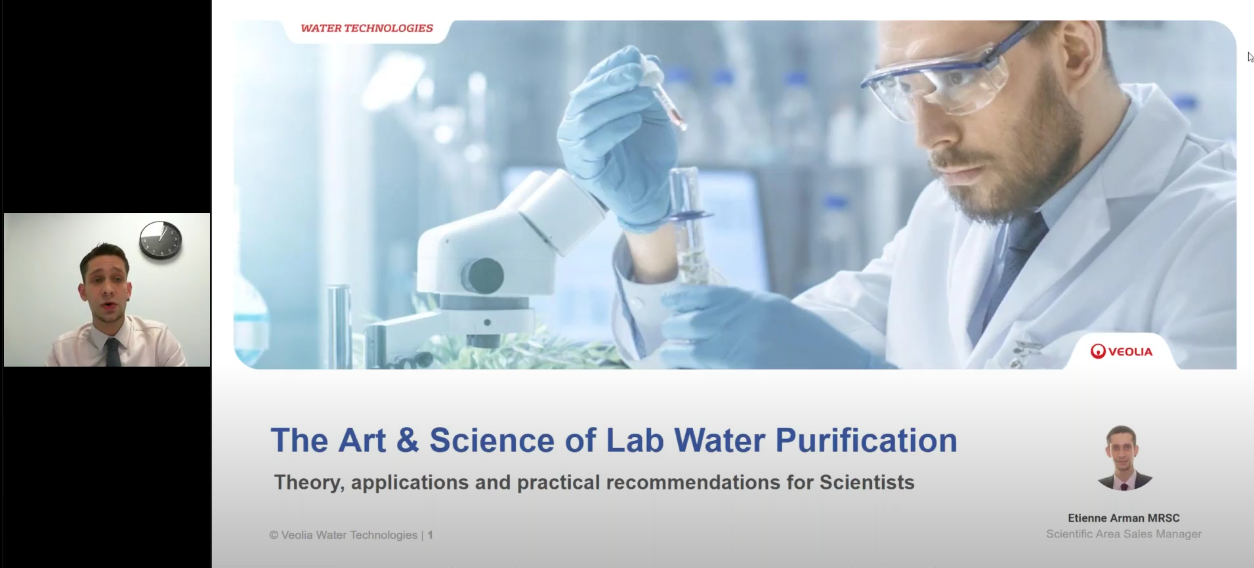Here, Etienne Arman, Scientific Area Sales Manager for Veolia Water Technologies UK (VWT UK) reflects on his time here at the company, talks a little about his role and the current challenges when it comes to lab water purification.
Could you tell us a bit about your background and your current role?
I started my career as a food scientist and managed to accumulate ten years of analytical research working at both Mondelēz International and then Douwe Egberts in a coffee lab. In July 2021, I began my role at VWT UK as a technical sales rep, specialising in the laboratory sector.
What attracted you to VWT UK?
-2.png?width=1230&height=518&name=Blog%20Headers%20(2)-2.png)
The company is known throughout the world thanks to its diverse range of water treatment solutions. Therefore, I knew that working for VWT UK would present me with huge opportunities to work on a variety of projects and develop my skills further.
In addition, I personally feel that VWT UK truly has an environmental conscience, which is something I have always admired.
You recently hosted a VWT UK webinar on the topic ‘Art and Science of Lab Water Purification’ - tell us about that.

At VWT UK, we produce plenty of specialised material aimed at scientists. However, we wanted to ensure that we were sharing knowledge that is accessible for a wider variety of roles within the supply chain and at varying degrees of experience.
With this in mind, we developed the Art and Science of Lab Water Purification webinar. It provides a simple and clear overview; looking at why pure water is required in scientific applications and some of the common issues such as water purity grading inconsistencies and the impurity absorption of ultra-pure water.
You mentioned water purity grading issues - how do different companies grade their water and why is this problematic?
-1.png?width=1230&height=518&name=Blog%20Headers%20(1)-1.png)
When we talk about water purification at VWT UK, we distinguish into three grades: type 1 – ultrapure water, type 2 – purified water, type 3 – primary grade water. However, individual companies tend to define these terms slightly differently, for example they might differ on measurement temperature.
Unfortunately, this can create ambiguity and customers will often ask for a higher water purification level than they need as they perceive this to be the safest option. However, this can lead to inefficiency and unnecessary costs.
What are some of the biggest challenges when it comes to specifying solutions for lab water treatment?
.png?width=1230&height=518&name=Blog%20Headers%20(6).png)
One of the main challenges we face is trying to help the customer understand that the water purifier is just one element of our solution – to deliver a reliable supply of pure water there are other elements involved, such as engineer labour, spare parts and maintenance. We also have other customers that come to us almost forgetting that we offer water treatment, rather than just water, pre-treated and ready to go.
The second challenge that we regularly face is that customers can be unclear about their own objectives. This becomes evident when we ask for technical information about their requirements, including the type of application the water will be used for, how often it will be used and also the flow rate required. Collectively this is known as a demand profile. This is an exceptionally useful tool for us, particularly in circumstances where there are a range of possible solutions, as it can help to focus on those that will be most appropriate – and most effective. However, in some cases, customers struggle to complete the demand profile for lack of clarity over their protocols.
From our perspective, the more information we are given the easier it is for us to complete a project. Ideally, a demand profile will be supplemented with a floor plan and a work pattern. This gives us a strong four-dimensional picture of the water demand across a variety of areas. We can then start working on designing a solution that meets the customer’s needs.
What are the key technologies used for lab-based water treatment?
.png?width=1230&height=518&name=Blog%20Headers%20(4).png)
At the centre of our product offering is reverse osmosis (RO) technology, which has been tailored for a broad range of contaminants. For further purification, we offer ion exchange, filtration and photoionisation. In fact, many of our products are able to deliver a combination of these technologies that work together to deliver the desired level of purification.
What are the four components of a successful lab application and why is ongoing maintenance important?
.png?width=1230&height=518&name=Blog%20Headers%20(3).png)
In my view, the four components are: capital investment, consumables, engineer labour and spare parts. Often, too much credit is given to the capital investment and by that - I mean the purifier itself. For a successful application, the other components will all need to work together effectively.
As is the case with all technologies, each of our solutions has a life span and needs to be maintained. Consumables can last six to twelve months and spare parts will need to be replaced following general wear and tear. As such, it is crucial that customers know and understand the maintenance requirements of their solution if it is to function with longevity and at maximum capacity.
How do you expect lab water treatment to change over the next 10-15 years?
.png?width=1230&height=518&name=Blog%20Headers%20(7).png)
I can see progress in two areas. First, sustainability. Lab practices are becoming increasingly influenced by environmental impact; with teams looking for ways to reduce their carbon footprint, consume less water and energy as well as use resources more efficiently.
The other is the move towards digitalisation. By using these technologies effectively, activities can be streamlined and lab professionals can diagnose faults quickly. Our Hubgrade digital services package uses a secure, cloud-based platform to deliver real-time monitoring and optimisation, and is becoming a valuable asset for those that adopt it into their processes.
To find out more about VWT UK’s Laboratory water Purification systems, please visit: https://www.veoliawatertechnologies.co.uk/markets/laboratory